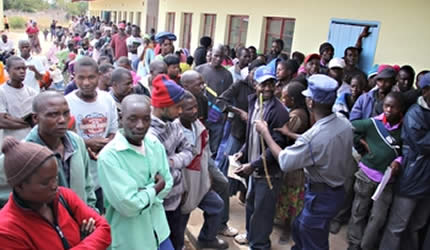Miners bemoan high royalties, levies

Treasury in January last year have increased the cost of mining operations, outgoing Chamber of Mines President Winston Chitando has said.
Mr Chitando made the remarks in his opening address at the Chamber of Mines of Zimbabwe’s 74th annual general meeting held at Troutbeck Resort last week under the theme “Where to from Here: Managing and Developing the Mineral Wealth of Zimbabwe for Tomorrow”.
Deputy Prime Minister Arthur Mutambara was the guest of honour at the function which was also attended by Youth Development, Indigenisation and Empowerment Minister Saviour Kasukuwere.
Mr Chitando, who was last week succeeded by Zimplats chief executive Mr Alex Mhembere as the new CoMZ president, said the upward review of the fees came as the burden from other charges had also grown.
He said that the high rates of royalties for gold (7 percent), platinum (10 percent) and diamonds (15 percent) which became effective from January 2012 increased the total operating cost of mining operations.
“This came at a time when the fiscal burden from other charges had also increased, resulting in a significant shift upwards in production costs. In early 2012, there was a steep increase in mining fees and charges relating mostly to acquisition and maintenance of mining title,” Mr Chitando said.
He said mining companies faced major challenges in terms of levies and charges yet the fragmented statutory and fiscal charges to the mining industry were and remain a major issue affecting viability and growth.
Speaking during a panel discussion later, Mr Chitando said the high cost of mining due to the numerous charges had rendered certain operations un- economic and forced companies to lower cut-off grades to maintain viability.
In response Mines and Mining Development Secretary Mr Prince Mupazvirihwo has said Government was actively looking into the concerns over high and numerous taxes and charges levied on mining companies.
“The issue is receiving active attention. You can be assured by the permanent secretary that these issues are being addressed,” Mr Mupazvirihwo said.
In early 2012, there was a steep increase in mining fees and charges relating mostly to acquisition and maintenance of mining titles. A lot of discussions with Government took place which resulted in a new set of charges early this year.
“Discussions are ongoing to have these changes streamlined and comparable to other mining jurisdictions. Other charges include RDC unit tax, Environmental Management Agency discharge fees, Mineral Marketing Corporation of Zimbabwe levy, Mandata levy, Standards Development Levy among others.”
The introduction of fees under the Radiation Protection Act and the Engineering Council of Zimbabwe Act added to these costs, Mr Chitando said, stressing the need for “Team Zimbabwe” to tackle the challenges.
Other challenges are that of electricity supply and access to long-term capital continue to be major constraints facing the mining industry. The Chamber of Mines of Zimbabwe, in conjunction with CZI, worked together in making representations to Zimbabwe Energy Regulatory Authority and Zesa Holdings.
Mr Chitando said the tariff for the ring-fenced electricity supply scheme was a thorny issue and took a significant amount of time and effort of the industry during the year. He also said the mining industry, which requires US$5-US$7 billion to recapitalise over the next five years, has failed to attract long term capital.
This has resulted in a number of members utilising expensive short- term capital affecting the ability to fund growth and operations. Of late, Mr Chitando said, the availability even of short-term capital had become constrained.
The ex-CoMZ boss said 2012 saw many minerals recording declines in production volumes compared to 2011. The exceptions were in diamonds, gold (13,47 percent), cobalt (11,81 percent), copper (1,69 percent), and iridium (3,4 percent).
He also pointed out that there was absolutely no need to debate whether or not platinum refining facilities should be established in Zimbabwe, adding the debate, or rather discussions, through the Platinum Producers’ Committee was for practical milestones for achieving platinum refining capacity in the country.








Comments